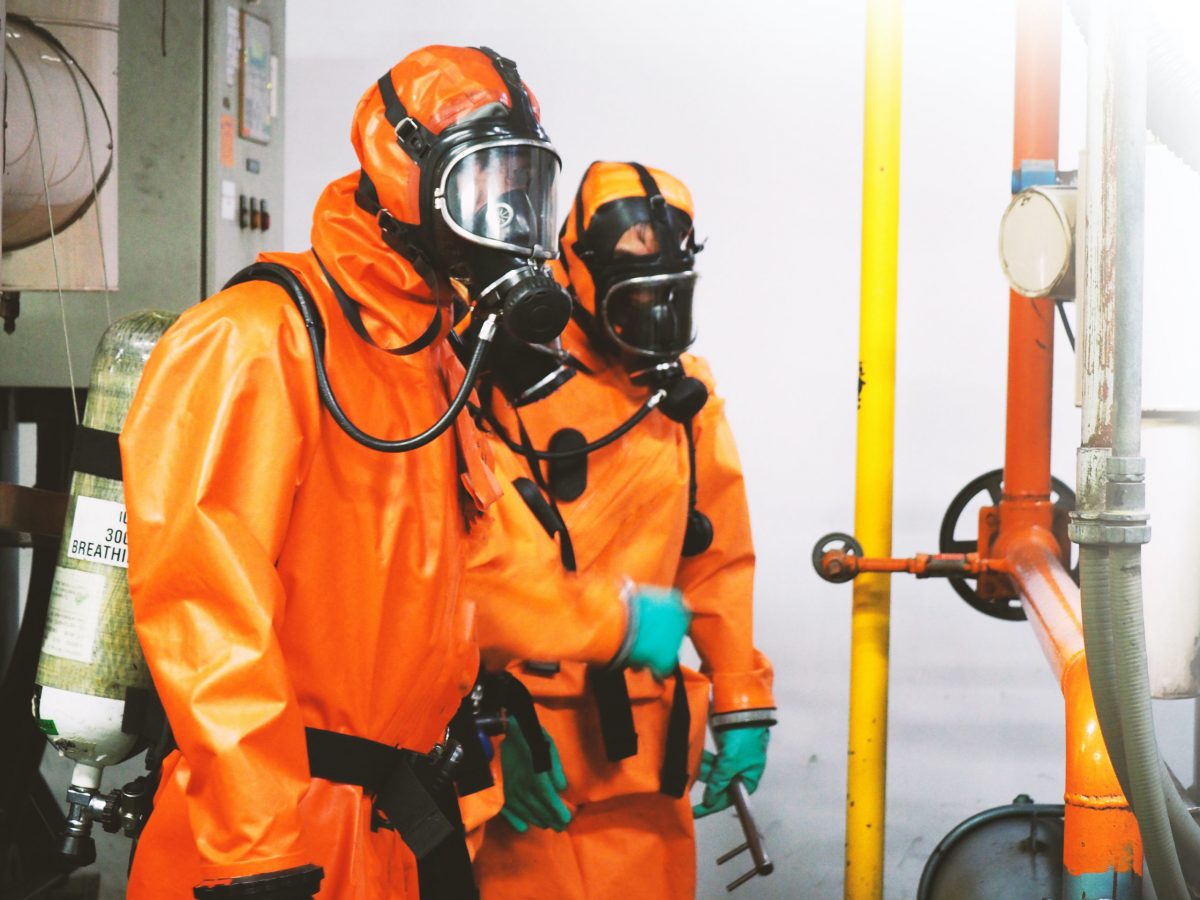Safety training is a cornerstone of any health and safety program. Effective training has the power to break bad habits, improve behaviors, and elevate safety overall.
While OSHA holds employers to extensive safety training standards in the US, voluntary standards like the ANSI/ASSP Z490.1 offer employers extended guidance on achieving environmental, health, and safety training program excellence.
How ANSI and ASSP Develop Standards
The American National Standards Institute (ANSI) accredits organizations that work with volunteer experts to develop voluntary standards. ANSI also sets the guidelines that these organizations use when developing a standard. The ultimate goal is to reach consensus on a standard so it can serve as a consistent baseline in the United States and beyond.
To develop a safety training standard, ANSI accredited the American Society of Safety Professionals (ASSP) to lead the standard-setting process and publish the standards. ANSI and ASSP believe that effective safety training should have several main components:
- Program management
- Content development
- Training delivery
- Evaluation
- Documentation
As a result, the ANSI/ASSP Z490 OSH training standards were born.
What is ANSI/ASSP Z490.1?
The Z490.1 standard sets the bar for workplace safety training. It includes criteria for developing, implementing, managing, documenting, and evaluating a safety training program.
“ANSI/ASSP Z490.1 is the gold standard for developing, delivering, and managing safety and health training in the USA,” explains Chip Darius, member of the Z490.1 standard development committee and founder and president of Safety Priority Consultants, LLC.
“Any company, regardless of size, can use the principles in Z490.1 to help get the best business value out of training investments, and to help make training as effective as possible for trainees,” says Darius.

This training standard assists companies in creating training that incorporates adult learning principles, different modes of learning, and hands-on activities.
What is the ANSI/ASSP Z490.2?
The ASSP also published the ANSI/ASSP Z490.2 standard as a supplement to Z490.1. It includes standards for integrating e-learning into safety, health, and environmental training programs.
This standard includes:
- Training program administration and management criteria for online delivery
- Standards for compliance with the Americans with Disabilities Act (ADA)
- Guidelines for evaluating the delivery technology and the learner’s technology skills
- Delivery of training in an online environment
Who Benefits from the ANSI/ASSP OSH Training Standards?
The ANSI/ASSP Z490 standards are beneficial for any organization responsible for training workers. They are particularly helpful for companies developing training curricula and end-to-end safety programs.
Ultimately, workers benefit from the OSH training standard. The consensus standard provides more detailed information on how to conduct training in such a way that employees are more likely to absorb what they’ve been taught.
4 Ways to Apply the ANSI/ASSP Z490.1
After you purchase the ANSI/ASSP safety standards, you’ll be equipped with a lot of information. We’ll cover four major areas of application, program design, training delivery, evaluation, and recordkeeping.
Designing and Creating a Training Program
Implementing an effective safety training program is great in theory, but how do companies practically bring ideas to fruition in the workplace? It starts from the ground up, designing and creating safety training that best fits the company’s needs.
The designing phase involves determining if a safety training program even applies to your company’s current issues or future needs. Standard Z490.1 recommends bringing in a skilled trainer, preferably one with CIT (Certified Instructional Trainer) certification.

“[The trainer] will assess the trainees’ skills, languages, and customs; desired training outcomes; applicable regulations and standards; available delivery and documentation methods; work environment, and other factors,” says Darius. “The needs assessment drives the creation of learning objectives, course design and content, and all elements of the training experience to achieve a quality outcome.”
During the design phase, the company will choose the type of training that will be most effective, taking the learning styles of the employees into account.
Other questions to consider when designing a training program:
- Who will be responsible for managing it?
- Will there be any training prerequisites?
- Where will the funding for the training come from?
- What are the end goals of safety training?
- Who will take the training? All employees? Select groups?
- Does the company’s insurance company have any requirements for safety training?
- How do we determine whether an employee passes the training?
If your company’s unique needs require the creation of original training materials, this would happen in the design phase as well. Course curricula and materials should be built around the OSHA participation to lecture ratio, with traditional media like PowerPoint presentations and handouts included — but only as a supplement to hands-on activities.
Deciding Between Training Styles
When creating the training program, you should also take into account who the trainer will be, whether they will be an outside trainer or someone from the company, and what qualifications they should have to lead training.
The trainer should be a subject matter expert in safety and also be highly knowledgeable in the company’s particular industry. Trainers should be able to show experience in a training environment and maintain their expertise through continuing education courses.

Depending on your company’s needs, the trainer can deliver the training in many different ways. Some of the most common forms of training include:
- Lecture-style in a classroom setting
- Hands-on demonstrations with practical tests
- Online through a pre-taped webinar or live video session, although OSHA has taken the stance that using only online training is not effective for safety training
- Combination of any of the above methods
According to Mr. Darius, the most effective delivery method is determined by the type of training a company needs, its desired outcomes, and any evaluations needed to assess the success of the training.
“For example, information-focused training may be delivered in-person, or by video, or on-line,” he says. “Skills-focused training may be a blend of media and in-person training, but there needs to be a hands-on portion where the trainee practices the skills with coaching and feedback in order to master the skill.”
Regardless of the method used, the trainer should be well-prepared for each session and aware of their audience and its learning styles.
Evaluating the Effectiveness of Safety Training
As you’re developing and creating your safety training, make notes of how best to evaluate the effectiveness of the training. The ANSI/ASSP Z490.1 standard utilizes the Kirkpatrick Four-Level Evaluation Method.
Like the name suggests, this evaluation technique includes assessing the training program at four levels—reaction, learning, behavior, and results.
Level 1 (Reaction): After the training, ask the employees for their immediate feedback and reactions to the course.
Level 2 (Learning): Test if the employees learned what they needed to learn by testing them or offering another form of assessment such as a practical exercise.
Level 3 (Behavior): In the days and weeks following the training, observe the employees to see if they’ve integrated the training points into their jobs.
Level 4 (Results): Determine whether the training helped the company meet the goals set out during the development process.
The evaluation process should also include reliable evaluations, whether written or practical, and a way to disperse evaluation results to employees if they want that information. Safety training strives for mastery of skills rather than just a pass/fail, according to Mr. Darius.
“Evaluation should be planned from the very beginning as an essential part of the learning process,” he says. “The evaluation should reliably determine whether the trainee has achieved the desired knowledge, skills, and abilities through the training process.”
Trainers should also be thinking of ways to re-train those employees who do not pass the assessments or need additional help.
Lastly, don’t just evaluate training effectiveness when you have time. Schedule it in so you don’t miss something important.
“Each training program should be flagged for periodic review, at appropriate intervals determined by the training program manager,” says Darius. “In addition, there may be trigger events that prompt a revamp, such as near-hits or changes in key performance indicators.”
Keeping Safety Training Records
Another key component of any safety training and program is detailed recordkeeping. The ANSI/ASSP standard offers suggestions for systems and procedures for keeping safety training records.
Safety training records should be kept confidential but available as needed for managers and other company leaders.
Once an employee completes training, they should receive a certificate of completion. The employee receives a copy of the certificate and the employer should also keep a copy.
Cost of ANSI/ASSP Z490 Standards
If you’re interested in applying the ANSI/ASSP Z490.1 or Z490.2 standards, they are available for purchase on the ASSP online store. ANSI/ASSP Z490.1 costs $110 to $140 for members and $150 to 180 for non-members and is available in a digital form or softcover. ANSI/ASSP Z490.2 is $110 for members and $150 for non-members.
Both standards include several additional resources including:
- Training course development guides
- Trainer’s checklist
- Virtual learning information
Alternatives to Purchasing the ANSI/ASSP OSH Training Standard
While the standards are affordable, you may not be ready to jump in headfirst. Check out OSHA’s Training Delivery PDF as a starting point, as it includes some of the information covered in the ANSI standards.
Also, remember that training consultants or vendors may be years ahead of your organization in applying ANSI standards to their materials. They may be a valuable resource as well.
Take Training to the Next Level
Safety training isn’t a quick fix, but it is a tool unlike any other. Training is a direct bridge to the people you’re trying to protect. It has the potential to correct difficult behavioral issues.
Take some time to examine your current safety training materials and activities. Check out trends and changes in your industry. You may need to go beyond compliance to ensure your employees have the training they really need. If so, the ANSI/ASSP 490.1 can be your guide.
To learn more, check out the ASSP Safety Standards and Tech Pubs Podcast episodes below:
